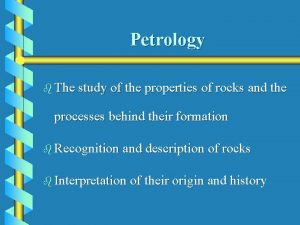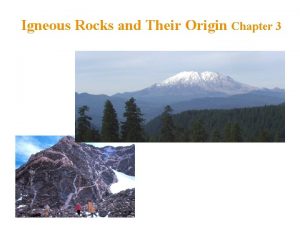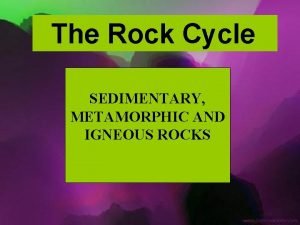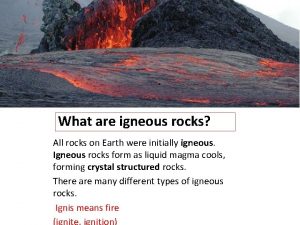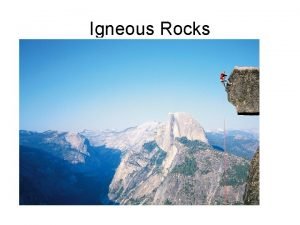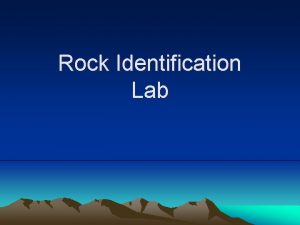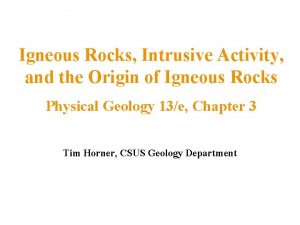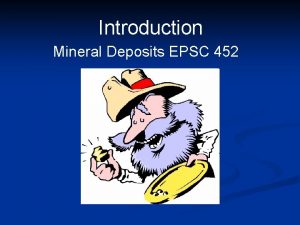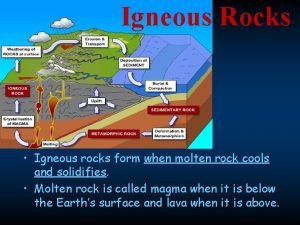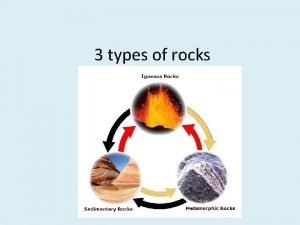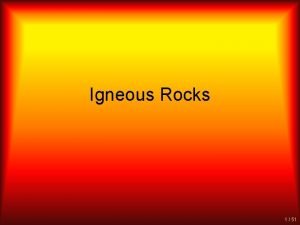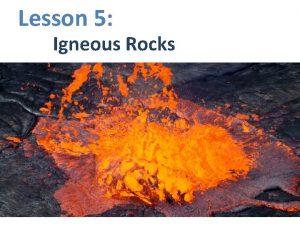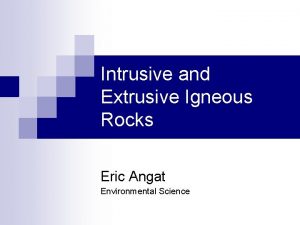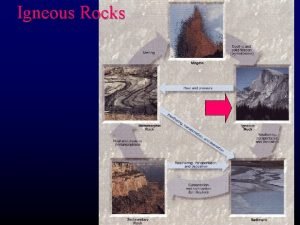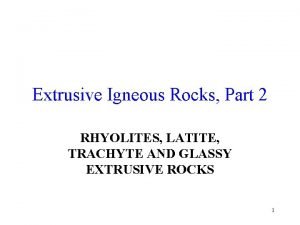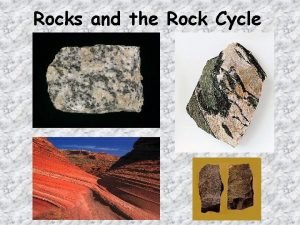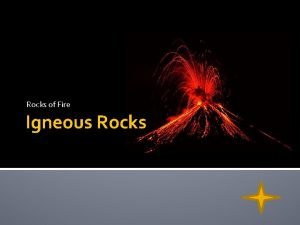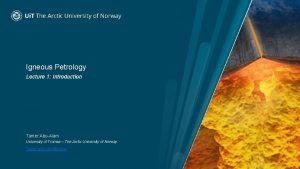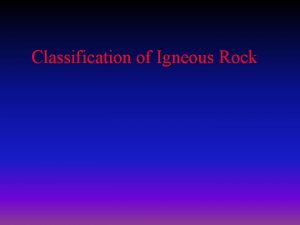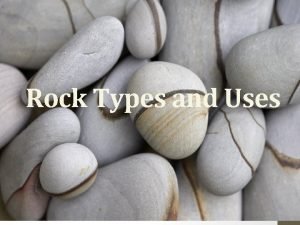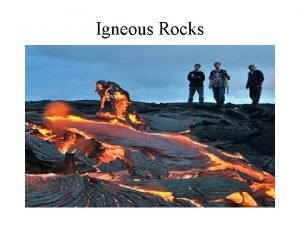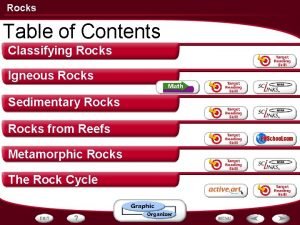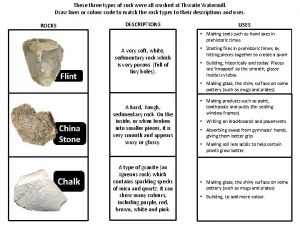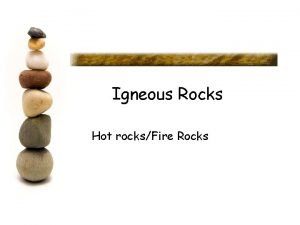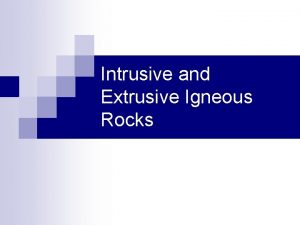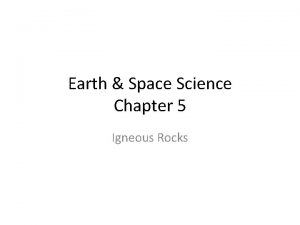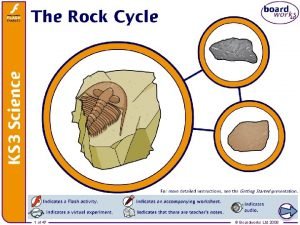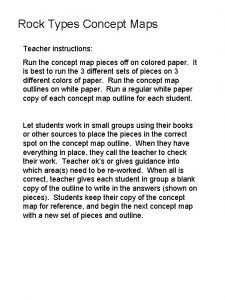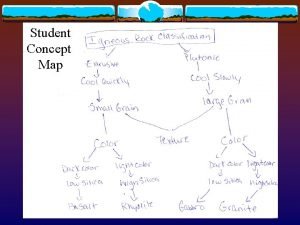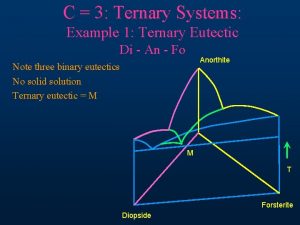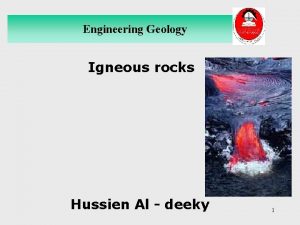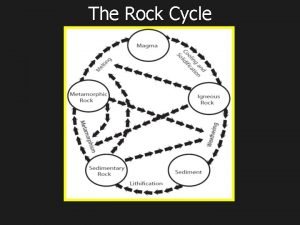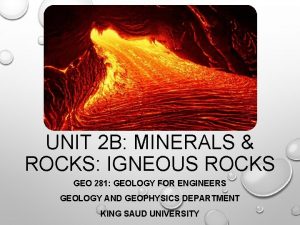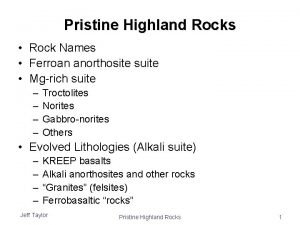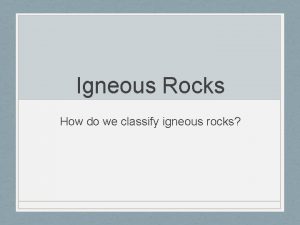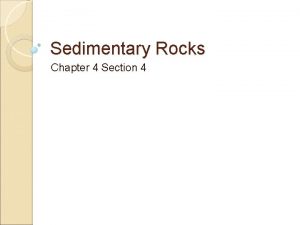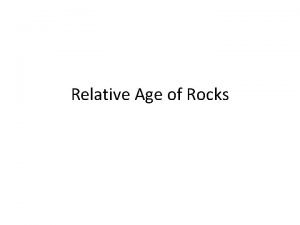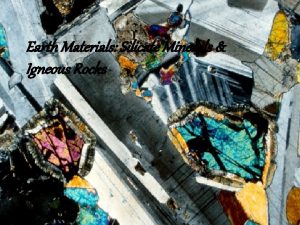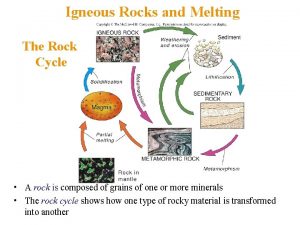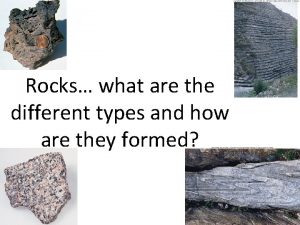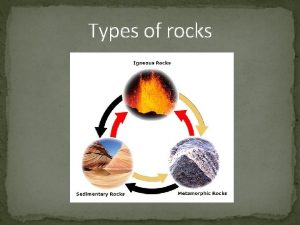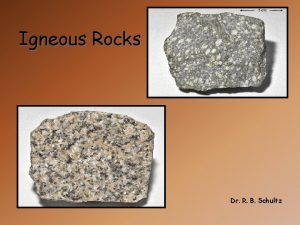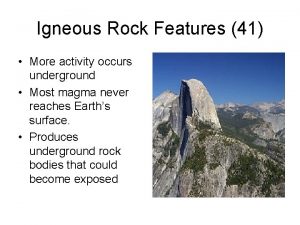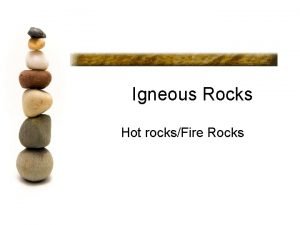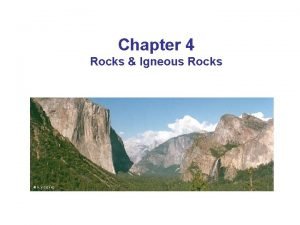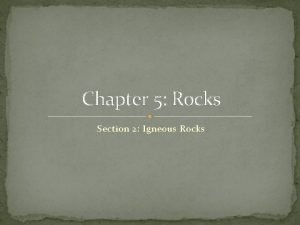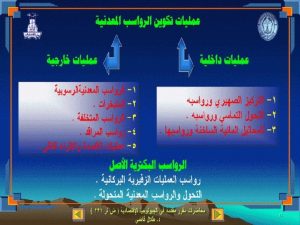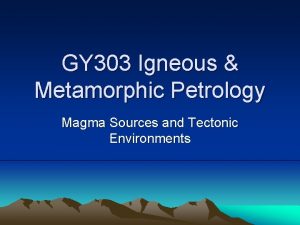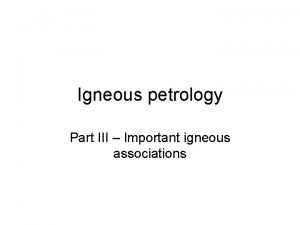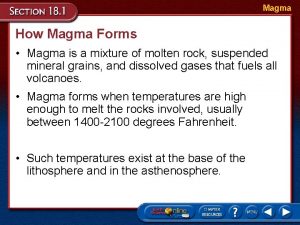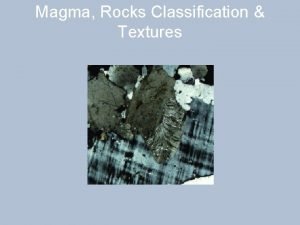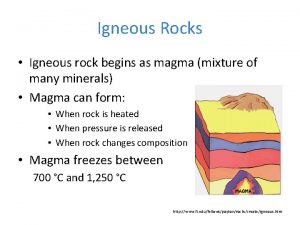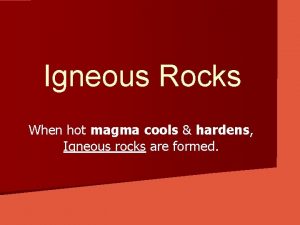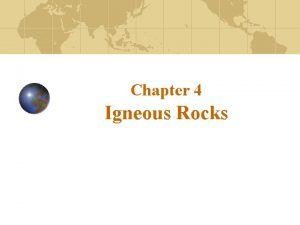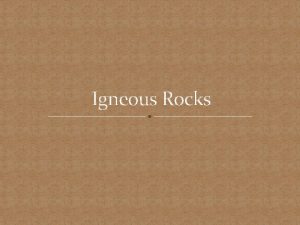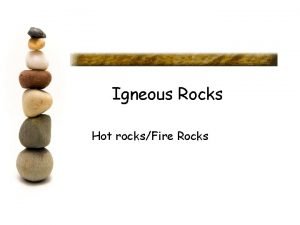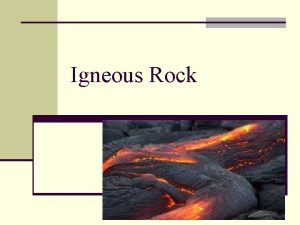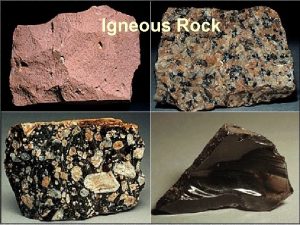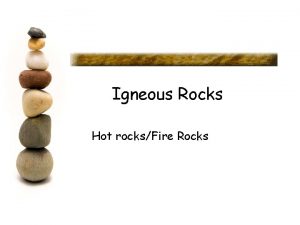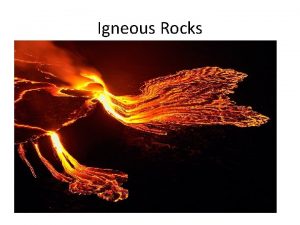Igneous Petrology Lecture 4 Magma generation Magma diversity












































































- Slides: 76

Igneous Petrology Lecture 4: Magma generation & Magma diversity Tamer Abu-Alam University of Tromsø – The Arctic University of Norway Tamer. abu-alam@uit. no

Alkali vs. Silica diagram for Hawaiian volcanics: Seems to be two distinct groupings: alkaline and subalkaline Total alkalis vs. silica diagram for the alkaline and sub-alkaline rocks of Hawaii. After Mac. Donald (1968). GSA Memoir 116

AFM diagram: can further subdivide the subalkaline magma series into a tholeiitic and a calc-alkaline series F AFM diagram showing the distinction between selected tholeiitic rocks from Iceland, the Mid-Atlantic Ridge, the Columbia River Basalts, and Hawaii (solid circles) plus the calc-alkaline rocks of the Cascade volcanics (open circles). From Irving and Baragar (1971). After Irvine and Baragar (1971). Can. J. Earth Sci. , 8, 523 -548. ic o l ei h it T Na 2 O + K 2 O (A), Fe. O + Fe 2 O 3 (F), and Mg. O (M) Calc-alkaline A M

2 principal types of basalt in the ocean basins Tholeiitic Basalt and Alkaline Basalt Common petrographic differences between tholeiitic and alkaline basalts Alkaline Basalt Tholeiitic Basalt Groundmass Usually fine-grained, intergranular Usually fairly coarse, intergranular to ophitic No olivine Olivine common Clinopyroxene = augite (plus possibly pigeonite) Titaniferous augite (reddish) Orthopyroxene (hypersthene) common, may rim ol. Orthopyroxene absent No alkali feldspar Interstitial alkali feldspar or feldspathoid may occur Interstitial glass and/or quartz common Interstitial glass rare, and quartz absent Olivine rare, unzoned, and may be partially resorbed Phenocrysts Olivine common and zoned or show reaction rims of orthopyroxene Orthopyroxene uncommon Orthopyroxene absent Early plagioclase common Plagioclase less common, and later in sequence Clinopyroxene is pale brown augite Clinopyroxene is titaniferous augite, reddish rims after Hughes (1982) and Mc. Birney (1993).

Primary magmas • Formed at depth and not subsequently modified by FX or Assimilation • Criteria • Highest Mg# (100 Mg/(Mg+Fe)) really parental magma • Experimental results of lherzolite melts • Mg# = 66 -75 • Cr > 1000 ppm • Ni > 400 -500 ppm • Multiply saturated (We refer to a melt that is saturated in several phases at once as a multiply saturated melt).

Multiple saturation l Low P F Ol then Plag then Cpx as cool F ~70 o. C T range Figure 10. 13 Anhydrous P-T phase relationships for a mid-ocean ridge basalt suspected of being a primary magma. After Fujii and Kushiro (1977). Carnegie Inst. Wash. Yearb. , 76, 461 -465.

Multiple saturation l l Low P F Ol then Plag then Cpx as cool F 70 o. C T range High P F Cpx then Plag then Ol Figure 10. 13 Anhydrous P-T phase relationships for a mid-ocean ridge basalt suspected of being a primary magma. After Fujii and Kushiro (1977). Carnegie Inst. Wash. Yearb. , 76, 461 -465.

Multiple saturation l l Low P F Ol then Plag then Cpx as cool F 70 o. C T range High P F Cpx l then Plag then Ol 25 km get all at once F= Multiple saturation F Suggests that 25 km is the depth of last eqm with the mantle

What is/are the source(s) of such parent or primary magma?

Sources of mantle material • Ophiolites • Slabs of oceanic crust and upper mantle • Thrust at subduction zones onto edge of continent • Dredge samples from oceanic crust • Nodules and xenoliths in some basalts • Kimberlite xenoliths • Diamond-bearing pipes blasted up from the mantle carrying numerous xenoliths from depth

Lherzolite is probably fertile unaltered mantle Dunite and harzburgite are refractory residuum after basalt has been extracted by partial melting Tholeiitic basalt 15 Wt. % Al 2 O 3 g Figure 10 -1 Brown and Mussett, A. E. (1993), The Inaccessible Earth: An Integrated View of Its Structure and Composition. Chapman & Hall/Kluwer. tin el l M 10 a rti Pa 5 Lherzolite Harzburgite Dunite 0 0. 2 Residuum 0. 4 Wt. % Ti. O 2 0. 6 0. 8

Lherzolite: A type of peridotite with Olivine > Opx + Cpx Olivine Dunite bu rgi Lherzolite hr Ha rz Peridotites We te 90 40 Pyroxenites Olivine Websterite Orthopyroxenite 10 10 Orthopyroxene Websterite Clinopyroxenite Figure 2. 2 C After IUGS Clinopyroxene

Phase diagram for aluminous 4 phase lherzolite: Al-phase = l Plagioclase F shallow (< 50 km) l Spinel F 50 -80 l km Garnet F 80 -400 l km Si VI coord. F Figure 10. 2 Phase diagram of aluminous lherzolite with melting interval (gray), sub-solidus reactions, > 400 km and geothermal gradient. After Wyllie, P. J. (1981). Geol. Rundsch. 70, 128 -153.

Seismic waves and the Earth’s Interior Longitudinal wave transverse wave

Variation in P and S wave velocities with depth. Compositional subdivisions of the Earth are on the left, rheological subdivisions on the right. After Kearey and Vine (1990), Global Tectonics. © Blackwell Scientific. Oxford.

How does the mantle melt? ? 1) Increase the temperature Figure 10. 3. Melting by raising the temperature.

2) Lower the pressure • Adiabatic rise of mantle with no conductive heat loss • Decompression partial melting could melt at least 30% Figure 10. 4. Melting by (adiabatic) pressure reduction. Melting begins when the adiabat crosses the solidus and traverses the shaded melting interval. Dashed lines represent approximate % melting.

3) Add volatiles (especially H 2 O) Figure 10. 4. Dry peridotite solidus compared to several experiments on H 2 O-saturated peridotites.

• Heating of amphibole-bearing peridotite 1) Ocean geotherm 2) Shield geotherm Figure 10. 6 Phase diagram (partly schematic) for a hydrous mantle system, including the H 2 O-saturated lherzolite solidus of Kushiro et al. (1968), the dehydration breakdown curves for amphibole (Millhollen et al. , 1974) and phlogopite (Modreski and Boettcher, 1973), plus the ocean and shield geotherms of Clark and Ringwood (1964) and Ringwood (1966). After Wyllie (1979). In H. S. Yoder (ed. ), The Evolution of the Igneous Rocks. Fiftieth Anniversary Perspectives. Princeton University Press, Princeton, N. J, pp. 483 -520.

Melts can be created under realistic circumstances • Plates separate and mantle rises at mid-ocean ridges • Adibatic rise decompression melting • Hot spots localized plumes of melt • Fluid fluxing may give LVL • Also important in subduction zones and other settings

Is melting of mantle enough to produce Alkaline and Tholiitic basaltic magma?

Generation of tholeiitic and alkaline basalts from a chemically uniform mantle Variables (other than X) • Temperature • Pressure Figure 10. 2 Phase diagram of aluminous lherzolite with melting interval (gray), sub-solidus reactions, and geothermal gradient. After Wyllie, P. J. (1981). Geol. Rundsch. 70, 128 -153.

Pressure effects: Figure 10. 8 Change in the eutectic (first melt) composition with increasing pressure from 1 to 3 GPa projected onto the base of the basalt tetrahedron. After Kushiro (1968), J. Geophys. Res. , 73, 619 -634.

Liquids and residuum of melted mantle (experimental) Figure 10. 9 After Green and Ringwood (1967). Earth Planet. Sci. Lett. 2, 151 -160.

Initial Conclusions: • Tholeiites favored by shallower melting • 25% melting at <30 km tholeiite • 25% melting at 60 km olivine basalt • Tholeiites favored by greater % partial melting (F) • 20 % melting at 60 km alkaline basalt • incompatibles (alkalis) initial melts • 30 % melting at 60 km tholeiite

Crystal Fractionation of magmas as they rise Figure 10. 10 Schematic representation of the fractional crystallization scheme of Green and Ringwood (1967) and Green (1969). After Wyllie (1971). The Dynamic Earth: Textbook in Geosciences. John Wiley & Sons.

Other, more recent experiments on melting of fertile (initially garnetbearing) lherzolite confirm that alkaline basalts are favored by high P and low F Figure 10. 11 After Kushiro (2001).

Summary • A chemically homogeneous mantle can yield a variety of basalt types • Alkaline basalts are favored over tholeiites by deeper melting and by low % PM • Fractionation at moderate to high depths can also create alkaline basalts from tholeiites Why alkaline magma can be produced at low %PM? ?

Review of REE sample/chondrite 10. 00 8. 00 6. 00 4. 00 2. 00 0. 00 La Ce Nd Sm Eu Tb Er Yb Lu atomic number increasing incompatibility

Review of REE Figure 9. 4. Rare Earth concentrations (normalized to chondrite) for melts produced at various values of F via melting of a hypothetical garnet lherzolite using the batch melting model (equation 9 -5). From Winter (2001) An Introduction to Igneous and Metamorphic Petrology. Prentice Hall. increasing incompatibility

Spider diagram for oceanic basalts increasing incompatibility Figure 10. 14 b. Spider diagram for a typical alkaline ocean island basalt (OIB) and tholeiitic midocean ridge basalt (MORB). From Winter (2001) An Introduction to Igneous and Metamorphic Petrology. Prentice Hall. Data from Sun and Mc. Donough (1989).

“Whole Mantle” circulation model Figure 10 -17 a After Basaltic Volcanism Study Project (1981). Lunar and Planetary Institute.

“Two-Layer” circulation model Upper depleted mantle = MORB source (tholiitic) F Lower undepleted & enriched OIB source (Alkaline) F Figure 10 -17 b After Basaltic Volcanism Study Project (1981). Lunar and Planetary Institute.

Experiments on melting enriched vs. depleted mantle samples: 1. Depleted Mantle • Tholeiite easily created by 10 -30% PM • More silica saturated at lower P Figure 10 -18 a. Results of partial melting experiments on depleted lherzolites. Dashed lines are contours representing percent partial melt produced. Strongly curved lines are contours of the normative olivine content of the melt. “Opx out” and “Cpx out” represent the degree of melting at which these phases are completely consumed in the melt. After Jaques and Green (1980). Contrib. Mineral. Petrol. , 73, 287 -310.

Experiments on melting enriched vs. depleted mantle samples: 2. Enriched Mantle l l Tholeiites extend to higher P than for DM Alkaline basalt field at higher P yet F And lower % PM Figure 10 -18 b. Results of partial melting experiments on fertile lherzolites. Dashed lines are contours representing percent partial melt produced. Strongly curved lines are contours of the normative olivine content of the melt. “Opx out” and “Cpx out” represent the degree of melting at which these phases are completely consumed in the melt. The shaded area represents the conditions required for the generation of alkaline basaltic magmas. After Jaques and Green (1980). Contrib. Mineral. Petrol. , 73, 287 -310.

So far, we can understand how the tholiitic and alkaline basaltic magma can be produced from mantle. What is about other types of rocks (acidic and intermediate magma)? ? ?

Diversification of Magmas

Magmatic Differentiation • Any process by which a magma is able to diversify and produce a magma or rock of different composition

Magmatic Differentiation l Two essential processes 1. Creates a compositional difference in one or more phases 2. Preserves the chemical difference by segregating (or fractionating) the chemically distinct portions

• • Partial Melting Crystal Fractionation Volatile Transport Liquid Immiscibility The Soret Effect and thermogravitational Diffusion Magma Mixing Assimilation

Partial Melting Separation of a partially melted liquid from the solid residue

Effects of removing liquid at various stages of melting l Eutectic systems First melt always = eutectic composition F Major element composition of eutectic melt is constant until one of the source mineral phases is consumed (trace elements differ) F Once a phase is consumed, the next increment of melt will be different X and T F

l l Separation of a partially melted liquid from the solid residue requires a critical melt % Sufficient melt must be produced for it to F Form a continuous, interconnected film F Have enough interior volume that it is not all of it is adsorbed to the crystal surfaces

The ability to form an interconnected film is dependent upon the dihedral angle ( ) a property of the melt Figure 11. 1 Illustration of the dihedral angle ( ) of melt droplets that typically form at multiple grain junctions. After Hunter (1987) In I. Parsons (ed. ), Origins of Igneous Layering. Reidel, Dordrecht, pp. 473 -504.

Crystal Fractionation l Dominant mechanism by which most magmas, once formed, differentiate?

Gravity settling F The differential motion of crystals and liquid under the influence of gravity due to their differences in density

Gravity settling F Cool point a olivine layer at base of pluton if first olivine sinks F Next get ol+cpx layer F finally get ol+cpx+plag Cumulate texture: Mutually touching phenocrysts with interstitial crystallized residual melt Figure 7 -2. After Bowen (1915), A. J. Sci. , and Morse (1994), Basalts and Phase Diagrams. Krieger Publishers.

Two other mechanisms that facilitate the separation of crystals and liquid 1. Compaction

Two other mechanisms that facilitate the separation of crystals and liquid 2. Flow segregation Figures 11. 4 and 11. 5 Drever and Johnston (1958). Royal Soc. Edinburgh Trans. , 63, 459 -499.

Figure 11. 2 Variation diagram using Mg. O as the abscissa for lavas associated with the 1959 Kilauea eruption in Hawaii. After Murata and Richter, 1966 (as modified by Best, 1982)

Polybaric Fractional Crystallization 1. Stability of phases will change (hi-P)

Polybaric Fractional Crystallization 1. Stability of phases changes (hi-P) 2. Shift of the eutectic point with pressure will cause the quantity of the liquidus phases to vary

Hi-P Low-P Ol Pyx

Volatile Transport 1. 2. 3. Vapor released by heating of hydrated or carbonated wall rocks As a volatile-bearing (but undersaturated) magma rises and pressure is reduced, the magma may eventually become saturated in the vapor, and a free vapor phase will be released A third mechanism for generating a separate fluid phase is a result of late-stage fractional crystallization

l l l Volatile release raises liquidus temperature porphyritic texture May increase P - fracture the roof rocks Vapor and melt escape along fractures as dikes F Silicate melt quartz and feldspar small dikes of aplite F Vapor phase dikes or pods of pegmatite

Concentrate incompatible elements F Complex: varied mineralogy s May display concentric zonation F Figure 11. 6 Sections of three zoned fluid-phase deposits (not at the same scale). a. Miarolitic pod in granite (several cm across). b. Asymmetric zoned pegmatite dike with aplitic base (several tens of cm across). c. Asymmetric zoned pegmatite with granitoid outer portion (several meters across). From Jahns and Burnham (1969). Econ. Geol. , 64, 843 -864.

8 cm tourmaline crystals from pegmatite The large grain size in magmagenic pegmatites is not due to a slow cooling rate but is a result of poor nucleation and very high diffusivity in the H 2 O-rich phase, which permits chemical species to migrate readily and add to rapidly growing minerals. 5 mm gold from a hydrothermal deposit

Pegmatites


Aplite dikes

Liquid Immiscibility l Liquid immiscibility in the Fo-Si. O 2 system Figure 6. 12. Isobaric T-X phase diagram of the system Fo-Silica at 0. 1 MPa. After Bowen and Anderson (1914) and Grieg (1927). Amer. J. Sci.

The effect of adding alkalis, alumina, etc. is to eliminate the solvus completely Figure 7. 4. Isobaric diagram illustrating the cotectic and peritectic curves in the system forsterite-anorthite-silica at 0. 1 MPa. After Anderson (1915) A. J. Sci. , and Irvine (1975) CIW Yearb. 74.

l Renewed interest when Roedder (1951) discovered a second immiscibility gap in the iron-rich Fa-Lc-Si. O 2 system Figure 11 -7. Two immiscibility gaps in the system fayaliteleucite-silica (after Roedder, 1979). Yoder (ed. ), The Evolution of the Igneous Rocks. Princeton University Press. pp. 15 -58. Projected into the simplified system are the compositions of natural immiscible silicate pair droplets from interstitial Ferich tholeiitic glasses (Philpotts, 1982). Contrib. Mineral. Petrol. , 80, 201 -218.

Some Examples • Late silica-rich immiscible droplets in Fe-rich tholeiitic basalts (as in Roedder) • Sulfide-silicate immiscibility (massive sulfide deposits) • Carbonatite-nephelinite systems (Chapter 19)

Compositional Convection and In Situ Differentiation Processes • In-situ: crystals don’t sink/move • Typically involves • Diffusion • Convective separation of liquid and crystals

The Soret Effect and Thermogravitational Diffusion • Thermal diffusion, or the Soret effect • Heavy elements/molecules migrate toward the colder end and lighter ones to the hotter end of the gradient

Walker and De. Long (1982) subjected two basalts to thermal gradients of nearly 50 o. C/mm (!) Found that: l Samples reached a steady state in a few days l Heavier elements cooler end and the lighter hot end Figure 7. 4. After Walker, D. C. and S. E. De. Long (1982). Contrib. Mineral. Petrol. , 79, 231 -240.

Hildreth (1979) 0. 7 Ma Bishop Tuff at Long Valley, California l Vertical compositional variation in the stratified tuff l Thermal gradient in chamber

Model Figure 11 -11. Schematic section through a rhyolitic magma chamber undergoing convection-aided in-situ differentiation. After Hildreth (1979). Geol. Soc. Amer. Special Paper, 180, 43 -75.

Langmuir Model l l Thermal gradient at wall and cap variation in % crystallized Compositional convection evolved magmas from boundary layer to cap (or mix into interior) Figure 11. 12 Formation of boundary layers along the walls and top of a magma chamber. From Winter (2001) An Introduction to Igneous and Metamorphic Petrology. Prentice Hall

Magma Mixing l l End member mixing for a suite of rocks Variation on Harker-type diagrams should lie on a straight line between the two most extreme compositions

Figure 11. 2 Variation diagram using Mg. O as the abscissa for lavas associated with the 1959 Kilauea eruption in Hawaii. After Murata and Richter, 1966 (as modified by Best, 1982)

Comingled basalt-Rhyolite Mt. Mc. Loughlin, Oregon Figure 11. 8 From Winter (2001) An Introduction to Igneous and Metamorphic Petrology. Prentice Hall Basalt pillows accumulating at the bottom of a in granitic magma chamber, Vinalhaven Island, Maine

Assimilation • Incorporation of wall rocks (diffusion, xenoliths) • Assimilation by melting is limited by the heat available in the magma

Mixed Processes l May be more than coincidence: two processes may operate in conjunction (cooperation? ) F AFC: FX supplies the necessary heat for assimilation F Fractional crystallization + recharge of more primitive magma

Tectonic-Igneous Associations
 Petrology is the study of
Petrology is the study of Second generation vs first generation antipsychotics
Second generation vs first generation antipsychotics We worship you hallelujah
We worship you hallelujah Genetic diversity vs species diversity
Genetic diversity vs species diversity Genetic diversity vs species diversity
Genetic diversity vs species diversity 01:640:244 lecture notes - lecture 15: plat, idah, farad
01:640:244 lecture notes - lecture 15: plat, idah, farad Shinny
Shinny Etamorph
Etamorph How igneous rocks are formed
How igneous rocks are formed It was a sedimentary rock song
It was a sedimentary rock song Concept map for igneous rocks
Concept map for igneous rocks Igneous rock formation
Igneous rock formation Igneous rock
Igneous rock Igneous rock identification lab
Igneous rock identification lab Is coal clastic organic or chemical
Is coal clastic organic or chemical Igneous rock
Igneous rock Bushveld igneous complex
Bushveld igneous complex Igneous rocks
Igneous rocks How are igneous rocks formed
How are igneous rocks formed The formation of igneous rocks
The formation of igneous rocks Extrusive vs intrusive igneous rocks
Extrusive vs intrusive igneous rocks Topography associated with massive igneous rocks
Topography associated with massive igneous rocks Pyroclastic rocks
Pyroclastic rocks Types of igneous rock
Types of igneous rock Describe igneous rocks
Describe igneous rocks Extrusive igneous rocks example
Extrusive igneous rocks example Igneous rock
Igneous rock Volcanic ash
Volcanic ash Rock cycle crayon lab answer key
Rock cycle crayon lab answer key Andesite felsic or mafic
Andesite felsic or mafic Igneous rock
Igneous rock Igneous rock defintion
Igneous rock defintion Iugs classification of igneous rocks
Iugs classification of igneous rocks Igneous rock
Igneous rock Igneous rocks metamorphic rocks and sedimentary rocks
Igneous rocks metamorphic rocks and sedimentary rocks Ultramafic rock classification
Ultramafic rock classification Rock types
Rock types What is the definition of an igneous rock
What is the definition of an igneous rock Concept map
Concept map Mechanical sedimentary rocks
Mechanical sedimentary rocks Igneous rocks
Igneous rocks Melted minerals
Melted minerals Classifying rocks
Classifying rocks Rhyolite mafic
Rhyolite mafic Characteristics igneous rocks
Characteristics igneous rocks Three types of igneous rocks
Three types of igneous rocks Felsic composition
Felsic composition Intrusive igneous rocks crystal size
Intrusive igneous rocks crystal size Intrusive igneous rocks
Intrusive igneous rocks Gneiss
Gneiss Vesicular rock
Vesicular rock Chapter 5 igneous rocks
Chapter 5 igneous rocks Igneous rock properties
Igneous rock properties Types of rock concept map
Types of rock concept map Sedimentary rock cycle
Sedimentary rock cycle How are sedimentary rocks
How are sedimentary rocks Concept map about rocks
Concept map about rocks Igneous ternary diagram
Igneous ternary diagram Igneous rock formation
Igneous rock formation Igneous rocks pronounce
Igneous rocks pronounce Igneous rock texture
Igneous rock texture Igneous rocks
Igneous rocks Igneous rock colors
Igneous rock colors Cementation sedimentary rocks
Cementation sedimentary rocks Marli miller
Marli miller Cooling rate
Cooling rate Igneous rocks
Igneous rocks Sedimentary deposition
Sedimentary deposition Igneous rocks
Igneous rocks How are metamorphic rocks formed
How are metamorphic rocks formed Igneous rock texture
Igneous rock texture Rock cycle song (sedimentary igneous metamorphic)
Rock cycle song (sedimentary igneous metamorphic) Underground igneous rock bodies are called
Underground igneous rock bodies are called Igneous rocks
Igneous rocks Rock definition
Rock definition Intrusive vs extrusive igneous rocks
Intrusive vs extrusive igneous rocks Chapter 5 igneous rocks
Chapter 5 igneous rocks
